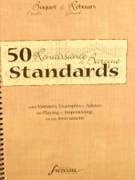Various (Rebours) Renaissance & Baroque Standards (50), w/Audio
Piano Classical/General Collections

-
Various (Rebours)
Renaissance & Baroque Standards (50), w/Audio (Rebours)
This collection is, for all intents and purposes, a "fakebook" of 50 Renaissance and Baroque pieces. Unlike a fakebook, the tunes are all presented in two-line format, with the tune in the top line and the bassline in the bottom. Accordingly, there are no chord changes written over the melody, rather Figured Bass is used (where numbers are shown over bass notes, giving the player direction as to the harmony for a given note). The collection of tunes is preceded by a lengthy 30+ page primer on playing this type of music. -cdpSays the publisher: With variants, examples and advice for playing and improvising on any instrument.
Here, brought together for the first time, you will find 50 Renaissance and Baroque ostinato basses, songs and dances on which composers repeatedly wrote variations over the course of decades or even centuries. These pieces circulated from country to country, from one publication or manuscript to another, and also served as a basis for improvisation by performing musicians of the time.
In the tradition of Jazz Standards anthologies are assembled over a hundred pages of the 50 most-used pieces in their basic versions, followed by transpositions and a selection of 210 variants and common derived forms. The examples are enriched with explanations, comments, historical notes and references, supported by the final glossary and bibliography. A generous preface provides theoretical analysis and practical hints for improvising.
These 50 ‘Standards’ are presented in increasing order of difficulty, and the musical examples may be used on three levels:
• The tunes are often easy, so beginners may play them as written.
• Musicians somewhat acquainted with the subject will be able to begin writing a few divisions or variations.
• With more experience, players can launch into free improvisation with no “safety net”, as one should.In addition, whether playing on modern or period instruments, any musician or group will be able to approach this repertoire in the following ways: • The melodic instruments (flute, violin, viol, oboe...) can play and vary the tunes and dances.
• Polyphonic instruments (keyboard, lute, guitar, harp) may accompany from the figured bass in various ways, and also realise independent versions by playing and varying the two parts at once.
• Low instruments (bass viol, bassoon, cello...) will take the bass line, without neglecting to add their own diminutions and variations.Lastly, this study provides an opportunity to explore a considerable part of the basic 16th and 17th century repertoire, while going deeper into certain harmonic, melodic and stylistic aspects characteristic of each period, each country and even each composer. Broadening the perspective to include improvisation, a practice not yet familiar enough, will add a new dimension to the approach to early music. -the publisher
-
- Category: Piano Classical/General Collections
- Item: 100373
- Grade/Level:
- Price: $54.95
-
(usually ships in 10 to 15 days)
